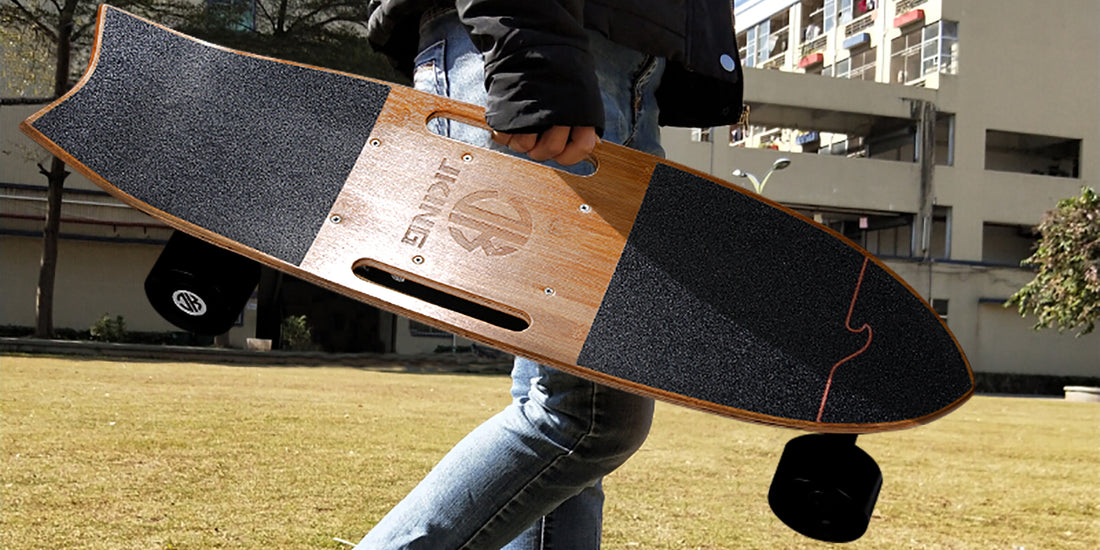
How to ride an electric skateboard. A Basic Guide for Beginners
Share
How to ride an electric skateboard. A Basic Guide for Beginners
Man rides JUPITER-02 electric skateboard on a bike path on a sunny day
Riding an electric skateboard may seem daunting, but it's actually quite easy to learn. In this beginner's guide, we'll show you how to ride an electric skateboard.
The first patent for a wireless electric skateboard was filed in 1999. Soon after, companies began releasing their versions of this fast, fun means of transportation. How are electric skateboards different from traditional skateboards? Are they hard to ride? Here's how to find out.
What's the difference between an electric skateboard and a regular skateboard?
At first glance, an electric skateboard and a regular skateboard look basically the same. The biggest difference is that an electric skateboard has one or more battery-powered motors. You operate the skateboard with a remote control, using various buttons and throttles to accelerate and brake. Some also have an LED display that shows important information such as riding mode, speed, battery level, etc.
Because electric skateboards use motors, they are usually much faster than regular skateboards. Today, even many affordable options can exceed speeds of 20 mph. Skateboards that use electric motors are also easier to get up hills and can travel longer distances. The last major difference is that most tricks are more challenging because the electrical components (especially the battery and motor) make the skateboard heavier. We will discuss which tricks are applicable to electric skateboards.
How to ride an electric skateboard
Now that you know what an electric skateboard is, how do you ride one? If you already have experience with a regular skateboard, you're at a great advantage. Riding an electric skateboard is not much different than riding a skateboard propelled by your feet, but it may take a little practice due to the speed and remote control. If you're new to skateboarding, it can be more challenging to learn. Here's what to do.
Step 1: Wear the right safety gear
Skaters with helmets in hand and wearing wrist guards
Before stepping on a skateboard - electric or regular - you need to put on the right equipment. This includes a proper helmet, wrist guards, elbow pads and knee pads. Wrist injuries are very common in skateboarding because when you fall, you're likely to extend your hands to catch yourself. Head injuries can be very serious, so be sure to wear a helmet that fits properly, but not so tight that it causes injury. It should sit flat on your head (not tilted back), so the front part is about an inch above your eyebrows.
If you normally use a regular skateboard and don't wear a lot of equipment, we highly recommend changing this. Because of how fast electric skateboards can go, they can be more dangerous than regular skateboards. The kind of shoes you wear is also important. Close-toed shoes that cover your feet are best (no sandals). Shoes with cushioning can even help dampen the effects of road vibration felt by your legs.
Step 2: Check your truck and setup
Close up of the electric skateboard truck
The skateboard truck is the two metal parts that attach to the bottom of the deck. One in the front and one in the back. If you're a beginner, it's best to make sure these trucks are nice and tight. This will help you balance better and reduce wobble at speed. As your skill level improves, you can gradually loosen them up to increase agility and sharper turns.
You should also familiarize yourself with the remote control before jumping on the skateboard. The skateboard has different modes to choose from, such as "forward" and "backward", as well as speed settings such as slow, medium and fast. Start with the slowest mode until you are sure you feel comfortable. If your skateboard has a different brake mode (such as JUPITER-01), we recommend that you also start with the lowest, most forgiving setting. Make sure the remote control is actually connected to the skateboard as well.

Step 3: Select skateboard stance
Recommended electronic skateboard stance infographic
If you've skateboarded before, you probably already have a natural stance that you feel comfortable with. Your snowboard stance (if you are snowboarding) will work as well. There are two main stances: the regular one and the awkward one. Regular is where you point your left foot in the direction of the nose of the board. Awkward means you lead with your right foot. Since most people are right-handed, it's common to lead with your left foot. That being said, if you are right-handed, this doesn't mean that regular stance always feels the most natural. There is no "right" stance, so just do what feels comfortable and stabilizes you the most.
Once you have your stance, think about how you feel on a skateboard. Are you stiff? You don't want to be wobbling around, but if your body is too stiff, you're more likely to fall. Put your arms out for balance, but don't hold them like bars of iron. Be prepared to bend your knees slightly as you slowly start riding; this bend will help you keep your balance.


